Difference between accessing cell elements using curly braces and parentheses
Think of cell array as a regular homogenic array, whose elements are all cells. Parentheses (()) simply access the cell wrapper object, while accessing elements using curly bracers ({}) gives the actual object contained within the cell.
For example,
A={ [5,6], 0 , 0 ,0 };
Will look like this:

The syntax of making an element equal to [] with parentheses is actually a request to delete that element, so when you ask to do foo(i) = [] you remove the i-th cell. It is not an assignment operation, but rather a RemoveElement operation, which uses similar syntax to assignment.
However, when you do foo{i} = [] you are assigning to the i-th cell a new value (which is an empty array), thus clearing the contents of that cell.
See the help in this link. As you'll see, accessing with parentheses (), gives you a subset of a cell (i.e. a sub-cell), while curly braces {} gives you the content of the cell you are trying to access.